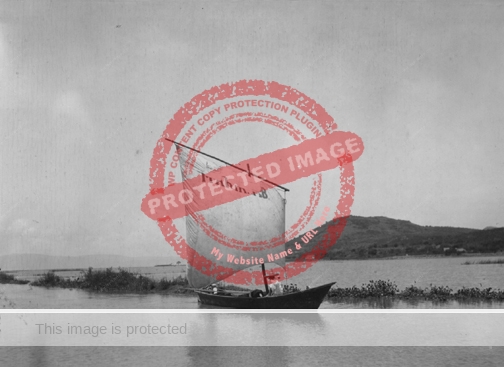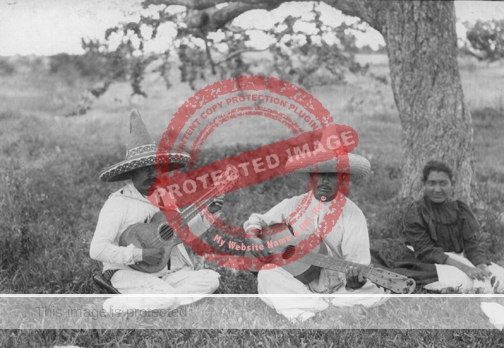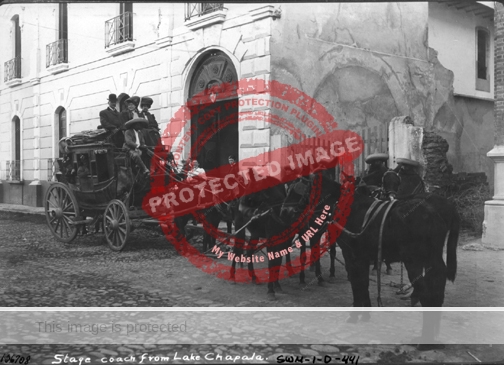American photographer Sumner W Matteson has not received the attention he deserves for the thousands of outstanding images of landscapes and people in the US, Cuba and Mexico he took at the start of the twentieth century.
Sumner Warren Matteson Jr was born on 15 September 1867 in Decorah, Iowa, and died in Mexico City on 27 Oct 1920. Following his death, the American Consulate in Mexico City curtly reported: “ASSETS: Miscellaneous articles of clothing of no intrinsic value. Given away and destroyed. Suitcase.” Matteson had only just celebrated his 53rd birthday.
German-Mexican photographer Hugo Brehme (1882-1954), based in Mexico City, had seen some of Matteson’s work and bought some of Matteson’s Mexican negatives from his estate. Brehme later printed some of them under his own copyright, sometimes with a note that the negatives were the work of Matteson.

Sumner W Matteson. 1907. “Native craft near outlet of Lake Chapala and water hyacinth drifting with the wind.” Reproduced courtesy of Milwaukee Public Museum, Wisconsin.
The photos in this post are reproduced by kind permission of the Milwaukee Public Museum in Wisconsin, which purchased them from the Matteson estate in 1922. Other Matteson negatives and prints can be found in the collections of the Science Museum of Minnesota in Saint Paul, the Field Museum of Natural History in Chicago and the Smithsonian Institution in Washington.
Matteson graduated with a B.S. degree from the University of Minnesota in 1888, and worked for a few years as a banking clerk before becoming an agent for a bicycle manufacturer, the Overman Wheel Company. By the end of the century, Matteson was calling himself an “amateur photographer” and a “traveling correspondent.”
In 1902 an album of his Hopi Indian photos was presented to the Smithsonian Institute, and Matteson documented several other indigenous groups in New Mexico and Arizona, as well as spending many months in Cuba.
The photos shown in this profile were all taken in 1907, during Matteson’s first trip to Mexico.

Sumner W Matteson. 1907. “Tramp musicians who carry copper coins in sombrero and silver coins in their ears (note 25 cent in ear nearest tree) taken near Hotel Ribera, Lake Chapala.” Reproduced courtesy of Milwaukee Public Museum, Wisconsin.
During this first visit to Mexico in 1907, Matteson spent 10 months climbing mountains and traveling around the Republic. A Mexico City daily described him as “the expert photographer who has traveled over a great portion of the world as the representative of a number of American newspapers, periodicals and magazines and whose work has evoked high commendation wherever it is known.”
Using Mexico City as his base, he climbed Popocatapetl and Orizaba volcanoes before succeeding in a 5-day ascent of “the most interesting and picturesque of them all”—Volcán de Fuego and Nevado de Colima, the twin volcanoes in Colima. Matteson succeeded in getting photos from inside the Nevado’s crater. From atop the Nevado, Matteson, and his small group—which included Samuel E Rogers of Ocotlán—could see from the Pacific Ocean to Lake Chapala.
On their way up the Volcán de Fuego, the climbing party happened across a “primitive ice plant,” where layers of hailstones were “gathered up in piles and placed in a layer—then with grass thrown on in, another layer is put on, and stamped down, and then wound in cloth and cut up in blocks of forty pounds each.”

Sumner W Matteson. 1907. “Stage coach from Lake Chapala.” Reproduced courtesy of Milwaukee Public Museum, Wisconsin.
Matteson’s second trip to Mexico was in 1920. After another successful ascent of Mt. Popocatepetl with some American friends, he stayed too long at the high altitude near the summit and developed pulmonary edema. He barely made it back to his hotel in Mexico City before he collapsed and died.
My 2022 book Lake Chapala: A Postcard History uses reproductions of more than 150 vintage postcards to tell the incredible story of how Lake Chapala became an international tourist and retirement center.
Sources
- Anja Müller, Gudrun Schumacher, Gregor Wolff. 2015. “Adventurer with Bike and Camera: Sumner W. Matteson (1867-1920),” pp 136-145 in Gregor Wolff (ed). 2015. Explorers and Entrepreneurs behind the Camera…. Berlin: Ibero-Amerikanisches Insitut.
- Louis B. Casagrande and Phillips Bourns. 1983. Side Trips: The Photography of Sumner W. Matteson, 1898-1908. Milwaukee Public Museum.
- The Mexican Herald: 23 June 1907, 12; 27 August 1907, 5.
- Great Falls Tribune: 24 October 1902.
Comments, corrections and additional material are welcome, whether via the comments feature or email.
Tony Burton’s books include “Lake Chapala: A Postcard History” (2022), “Foreign Footprints in Ajijic” (2022), “If Walls Could Talk: Chapala’s historic buildings and their former occupants” (2020), (available in translation as “Si Las Paredes Hablaran”), “Mexican Kaleidoscope” (2016), and “Lake Chapala Through the Ages” (2008).
I have to absorb this a bit–but for now I want to offer this summery:
WOW
Thanks!!!